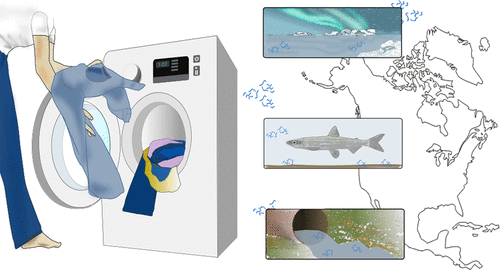当前位置:
X-MOL 学术
›
Environ. Sci. Technol. Lett.
›
论文详情
Our official English website, www.x-mol.net, welcomes your feedback! (Note: you will need to create a separate account there.)
The Widespread Environmental Footprint of Indigo Denim Microfibers from Blue Jeans
Environmental Science & Technology Letters ( IF 10.9 ) Pub Date : 2020-09-02 , DOI: 10.1021/acs.estlett.0c00498 Samantha N. Athey 1 , Jennifer K. Adams 1 , Lisa M. Erdle 2 , Liisa M. Jantunen 1, 3 , Paul A. Helm 4, 5 , Sarah A. Finkelstein 1 , Miriam L. Diamond 1, 5
Environmental Science & Technology Letters ( IF 10.9 ) Pub Date : 2020-09-02 , DOI: 10.1021/acs.estlett.0c00498 Samantha N. Athey 1 , Jennifer K. Adams 1 , Lisa M. Erdle 2 , Liisa M. Jantunen 1, 3 , Paul A. Helm 4, 5 , Sarah A. Finkelstein 1 , Miriam L. Diamond 1, 5
Affiliation

|
At any moment, approximately half of the world’s population is wearing blue jeans and other denim garments. We examine the footprint of our modern blue jean society by investigating the environmental distribution, pathways, and sources of indigo denim microfibers shed by denim clothing. Microfibers comprised 87–90% of the anthropogenic particles found in sediments from the Canadian Arctic Archipelago, Laurentian Great Lakes, and shallow suburban lakes in southern Ontario. Twenty-one to fifty-one percent of all microfibers in sediments were anthropogenically modified cellulose (AC), of which 40–57% were indigo denim microfibers (12–23% of all microfibers analyzed). AC microfibers were also found in rainbow smelt from the Great Lakes. Wastewater treatment plant effluent collected in southern Ontario contained 22 ± 18 microfibers L–1, 13% of which were dyed with indigo, characteristic of denim fabrics. Finally, as a source for introduction into wastewater, we found that one pair of used jeans can release 56000 ± 4100 microfibers per wash. Microfibers from jean laundering were consistent in chemical composition and morphology with those found in the environment. We conclude that blue jeans, the world’s single most popular garment, are an indicator of the widespread burden of anthropogenic pollution by adding significantly to the environmental accumulation of microfibers from temperate to Arctic regions.
中文翻译:

蓝色牛仔裤靛蓝牛仔布超细纤维的广泛环境足迹
在任何时候,大约一半的世界人口都穿着蓝色牛仔裤和其他牛仔服装。我们通过调查牛仔布服装脱落的靛蓝牛仔布超细纤维的环境分布,途径和来源,来检验我们现代蓝色牛仔裤社会的足迹。在加拿大北极群岛,Laurentian大湖和安大略省南部郊区的浅湖沉积物中发现的超细纤维占人为颗粒的87–90%。沉积物中所有微纤维的21%至51%是人为改性纤维素(AC),其中靛蓝牛仔布微纤维为40%至57%(分析的所有微纤维中为12%至23%)。在五大湖的彩虹熔炼中还发现了交流超细纤维。在安大略省南部收集的污水处理厂废水中含有22±18微纤维L–1,其中13%用靛蓝染色,这是牛仔布的特征。最后,作为引入废水的来源,我们发现,一条旧牛仔裤每洗一次可释放56000±4100微纤维。牛仔布洗涤产生的超细纤维的化学组成和形态与环境中的一致。我们得出的结论是,蓝色牛仔裤是世界上最受欢迎的单一服装,它通过显着增加从温带到北极地区的超细纤维在环境中的蓄积,来指示人为污染的广泛负担。
更新日期:2020-09-02
中文翻译:

蓝色牛仔裤靛蓝牛仔布超细纤维的广泛环境足迹
在任何时候,大约一半的世界人口都穿着蓝色牛仔裤和其他牛仔服装。我们通过调查牛仔布服装脱落的靛蓝牛仔布超细纤维的环境分布,途径和来源,来检验我们现代蓝色牛仔裤社会的足迹。在加拿大北极群岛,Laurentian大湖和安大略省南部郊区的浅湖沉积物中发现的超细纤维占人为颗粒的87–90%。沉积物中所有微纤维的21%至51%是人为改性纤维素(AC),其中靛蓝牛仔布微纤维为40%至57%(分析的所有微纤维中为12%至23%)。在五大湖的彩虹熔炼中还发现了交流超细纤维。在安大略省南部收集的污水处理厂废水中含有22±18微纤维L–1,其中13%用靛蓝染色,这是牛仔布的特征。最后,作为引入废水的来源,我们发现,一条旧牛仔裤每洗一次可释放56000±4100微纤维。牛仔布洗涤产生的超细纤维的化学组成和形态与环境中的一致。我们得出的结论是,蓝色牛仔裤是世界上最受欢迎的单一服装,它通过显着增加从温带到北极地区的超细纤维在环境中的蓄积,来指示人为污染的广泛负担。



























 京公网安备 11010802027423号
京公网安备 11010802027423号